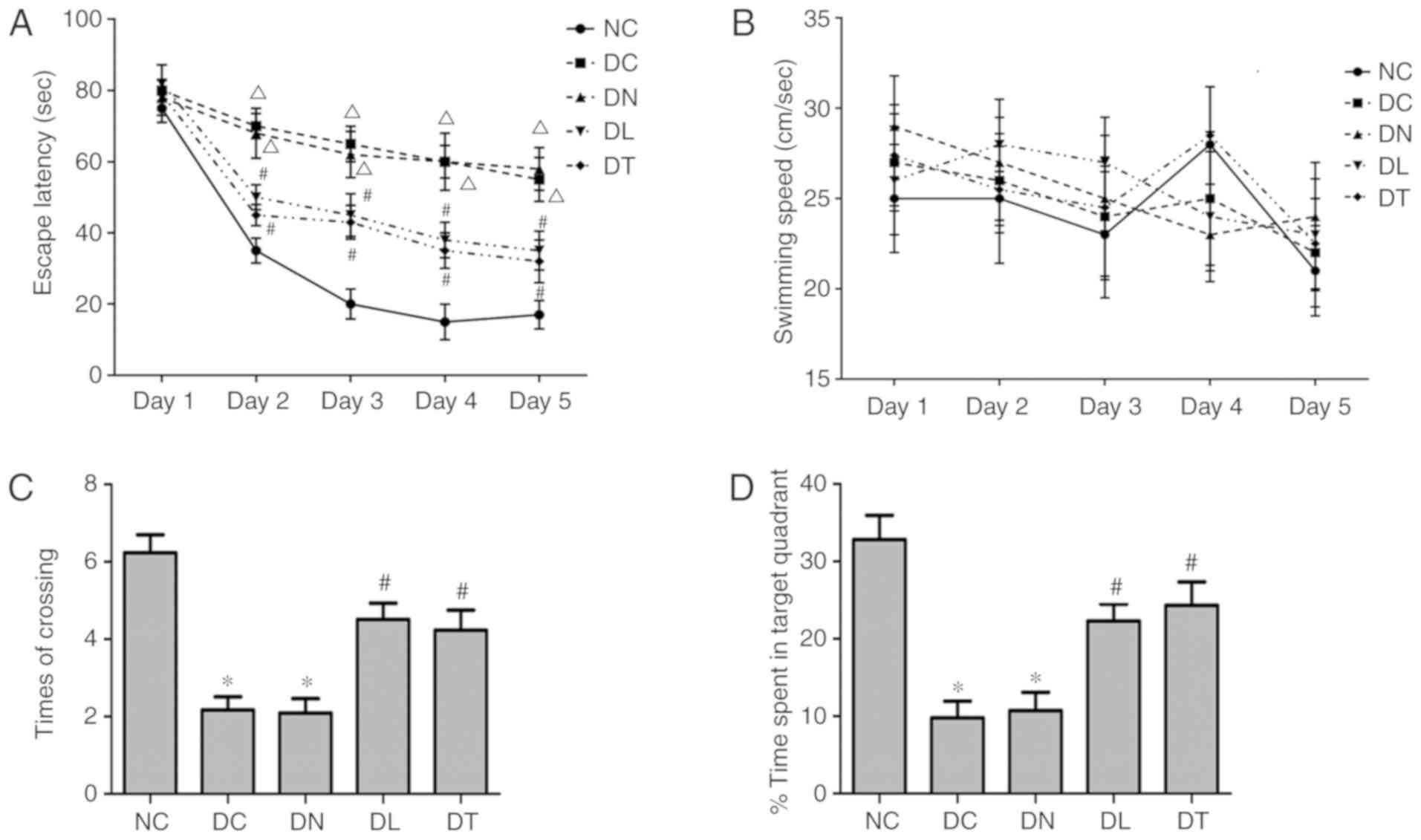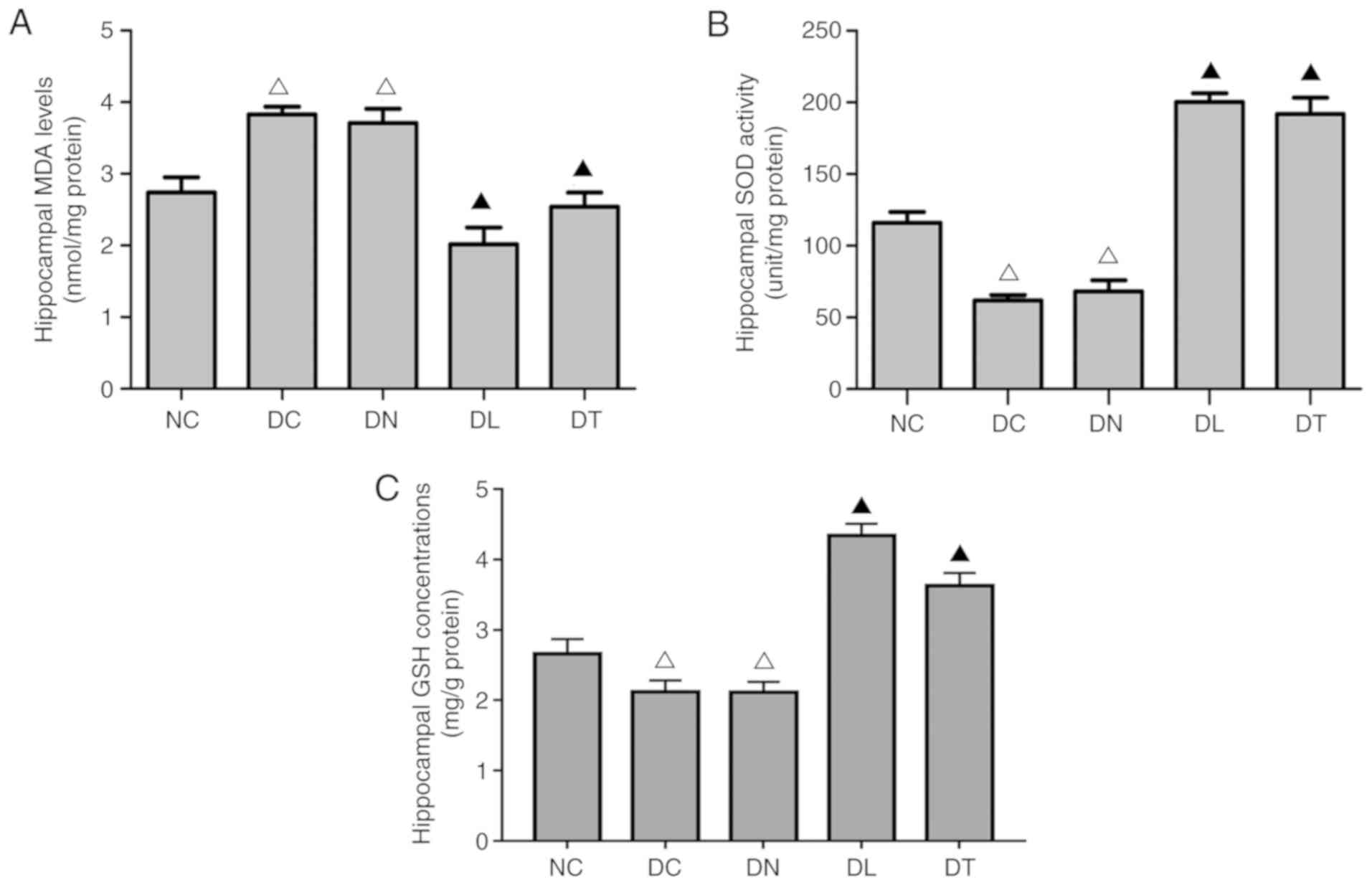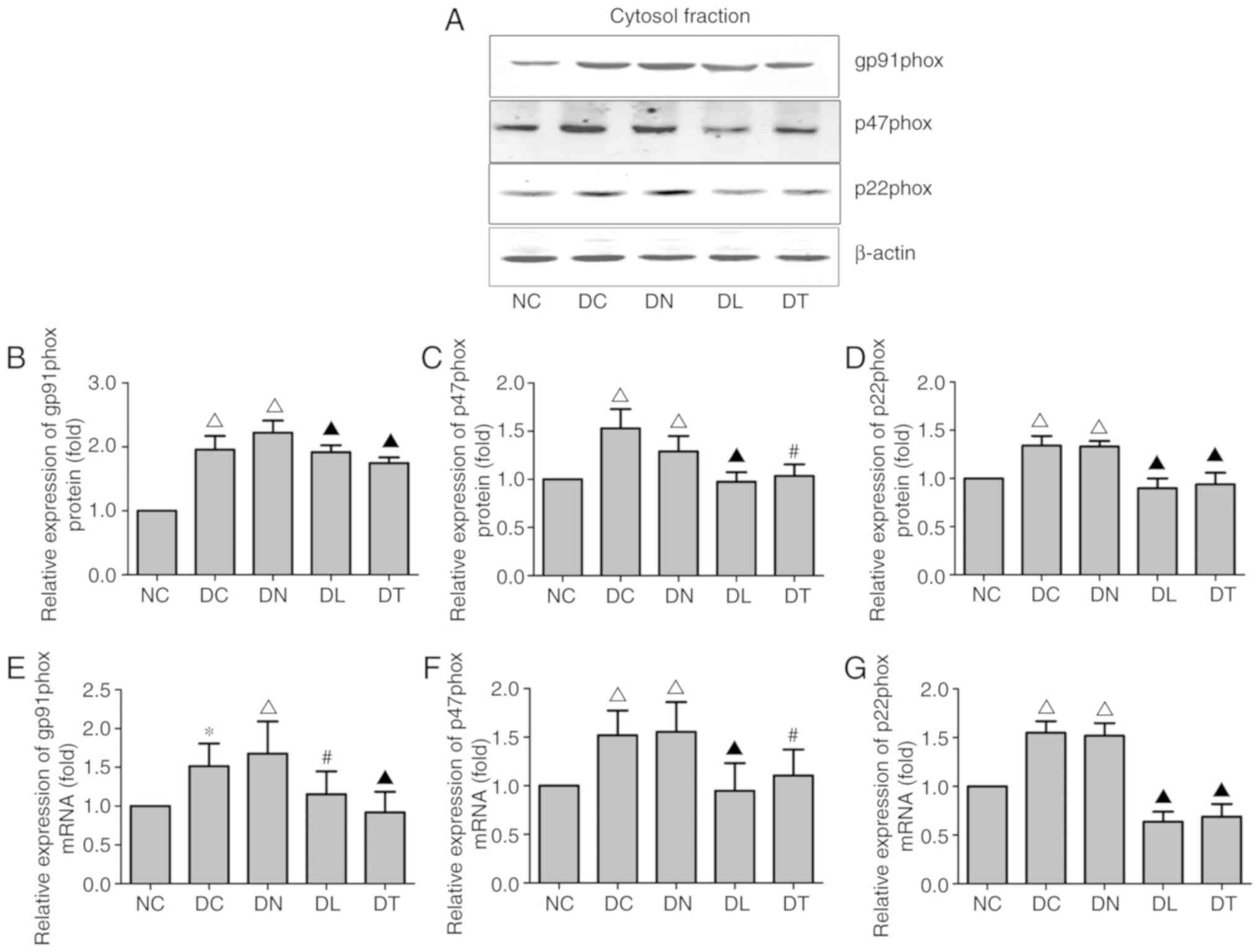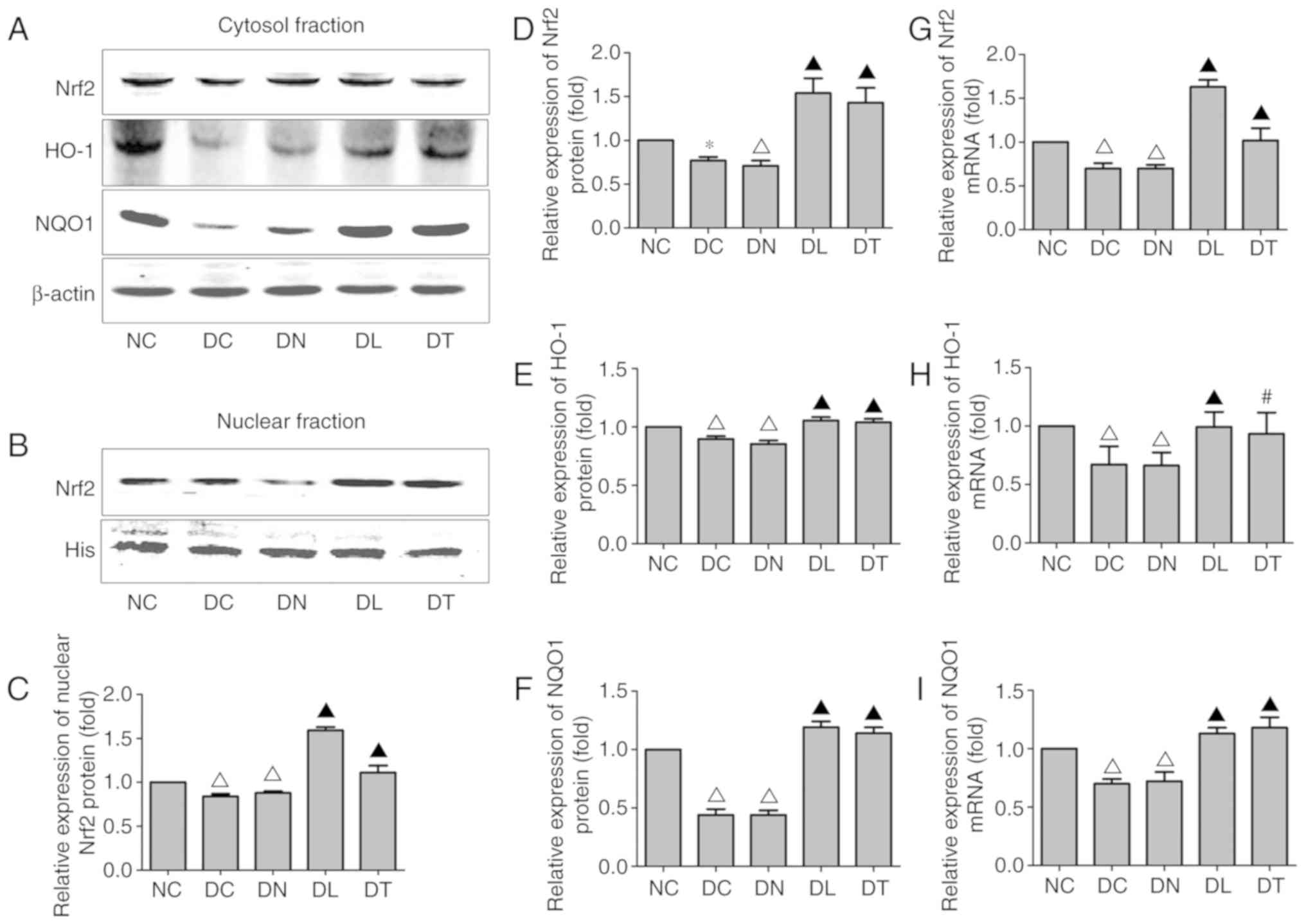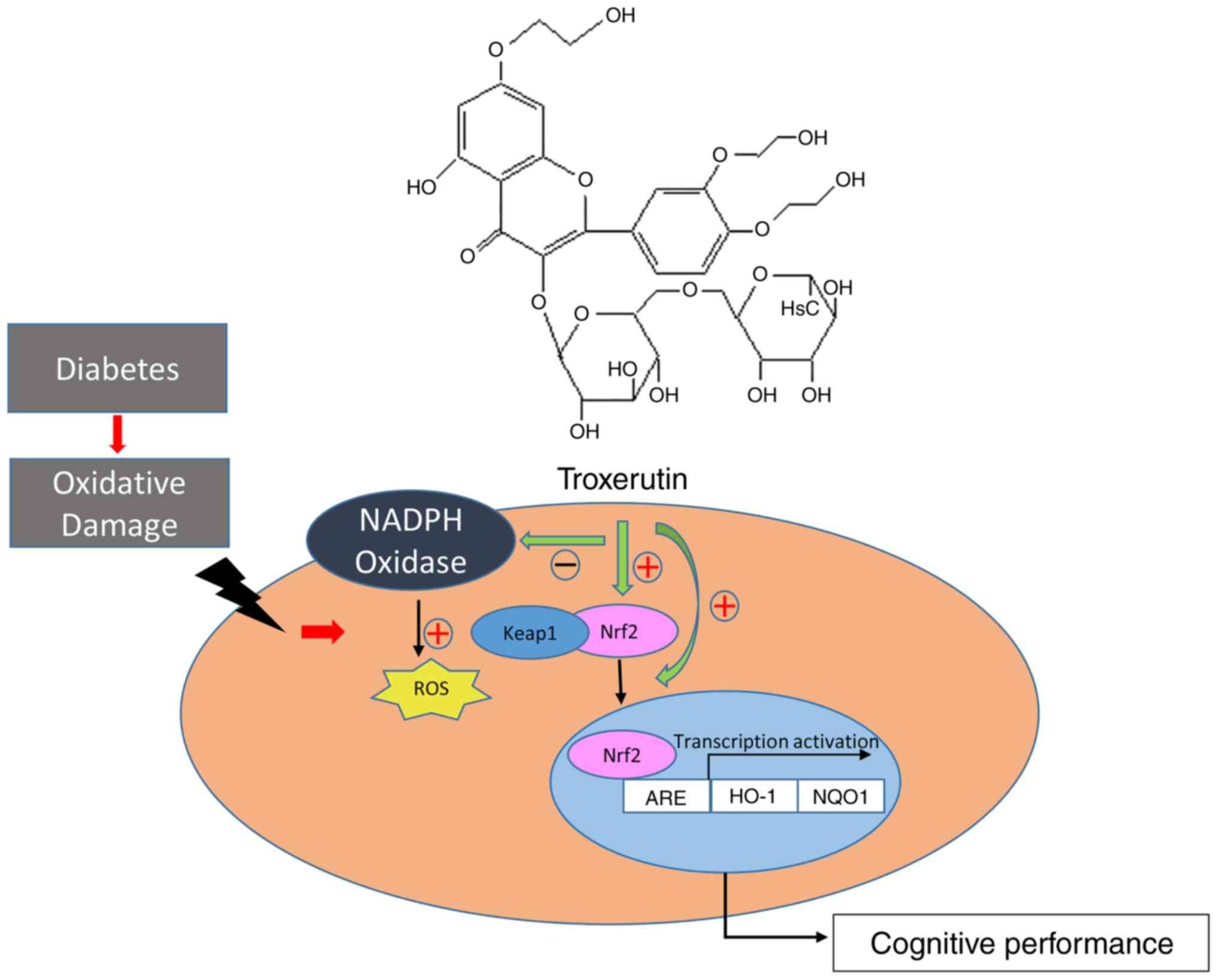|
1
|
Guariguata L, Whiting DR, Hambleton I,
Beagley J, Linnenkamp U and Shaw JE: Global estimates of diabetes
prevalence for 2013 and projections for 2035. Diabetes Res Clin
Pract. 103:137–149. 2014. View Article : Google Scholar : PubMed/NCBI
|
|
2
|
Koekkoek PS, Kappelle LJ, van den Berg E,
Rutten GE and Biessels GJ: Cognitive function in patients with
diabetes mellitus: Guidance for daily care. Lancet Neurol.
14:329–340. 2015. View Article : Google Scholar : PubMed/NCBI
|
|
3
|
Mijnhout GS, Scheltens P, Diamant M,
Biessels GJ, Wessels AM, Simsek S, Snoek FJ and Heine RJ: Diabetic
encephalopathy: A concept in need of a definition. Diabetologia.
49:1447–1448. 2006. View Article : Google Scholar : PubMed/NCBI
|
|
4
|
Biessels GJ and Despa F: Cognitive decline
and dementia in diabetes mellitus: Mechanisms and clinical
implications. Nat Rev Endocrinol. 14:591–604. 2018. View Article : Google Scholar : PubMed/NCBI
|
|
5
|
Gao M, Ji S, Li J and Zhang S:
DL-3-n-butylphthalide (NBP) ameliorates cognitive deficits and
CaMKII-mediated long-term potentiation impairment in the
hippocampus of diabetic db/db mice. Neurol Res. 41:1024–1033. 2019.
View Article : Google Scholar : PubMed/NCBI
|
|
6
|
Li J, Zhang S, Zhang L, Wang R and Wang M:
Effects of L-3-n-butylphthalide on cognitive dysfunction and NR2B
expression in hippocampus of streptozotocin (STZ)-induced diabetic
rats. Cell Biochem Biophys. 71:315–322. 2015. View Article : Google Scholar
|
|
7
|
Zhang SY, Ji SX, Bai XM, Yuan F, Zhang LH
and Li J: L-3-n-butylphthalide attenuates cognitive deficits in
db/db diabetic mice. Metab Brain Dis. 34:309–318. 2019. View Article : Google Scholar
|
|
8
|
Muriach M, Flores-Bellver M, Romero FJ and
Barcia JM: Diabetes and the brain: Oxidative stress, inflammation,
and autophagy. Oxid Med Cell Longev. 2014:1021582014. View Article : Google Scholar : PubMed/NCBI
|
|
9
|
Cobley JN, Fiorello ML and Bailey DM: 13
reasons why the brain is susceptible to oxidative stress. Redox
Biol. 15:490–503. 2008. View Article : Google Scholar
|
|
10
|
Yang H, Jin X, Kei Lam CW and Yan SK:
Oxidative stress and diabetes mellitus. Clin Chem Lab Med.
49:1773–1782. 2011. View Article : Google Scholar : PubMed/NCBI
|
|
11
|
Elsherbiny NM, Zaitone SA, Mohammad HMF
and El-Sherbiny M: Renoprotective effect of nifuroxazide in
diabetes-induced nephropathy: Impact on NFκB, oxidative stress, and
apoptosis. Toxicol Mech Methods. 28:467–473. 2018. View Article : Google Scholar : PubMed/NCBI
|
|
12
|
Aboualizadeh E, Ranji M, Sorenson CM,
Sepehr R, Sheibani N and Hirschmugl CJ: Retinal oxidative stress at
the onset of diabetes determined by synchrotron FTIR widefield
imaging: Towards diabetes pathogenesis. Analyst. 142:1061–1072.
2017. View Article : Google Scholar : PubMed/NCBI
|
|
13
|
Ravassa S, Beaumont J, Huerta A, Barba J,
Coma-Canella I, González A, López B and Díez J: Association of low
GLP-1 with oxidative stress is related to cardiac disease and
outcome in patients with type 2 diabetes mellitus: A pilot study.
Free Radic Biol Med. 81:1–12. 2015. View Article : Google Scholar : PubMed/NCBI
|
|
14
|
Mecocci P, Boccardi V, Cecchetti R,
Bastiani P, Scamosci M, Ruggiero C and Baroni M: A long journey
into aging, brain aging, and Alzheimer's disease following the
oxidative stress tracks. J Alzheimers Dis. 62:1319–1335. 2018.
View Article : Google Scholar : PubMed/NCBI
|
|
15
|
Maciejczyk M, Żebrowska E and Chabowski A:
Insulin resistance and oxidative stress in the brain: What's new?
Int J Mol Sci. 20:8742019. View Article : Google Scholar
|
|
16
|
Kim J, Cho CH, Hahn HG, Choi SY and Cho
SW: Neuroprotective effects of N-adamantyl-4-methylthiazol-2-amine
against amyloid β-induced oxidative stress in mouse hippocampus.
Brain Res Bull. 128:22–28. 2017. View Article : Google Scholar
|
|
17
|
Tian X, Liu Y, Ren G, Yin L, Liang X, Geng
T, Dang H and An R: Resveratrol limits diabetes-associated
cognitive decline in rats by preventing oxidative stress and
inflammation and modulating hippocampal structural synaptic
plasticity. Brain Res. 1650:1–9. 2016. View Article : Google Scholar : PubMed/NCBI
|
|
18
|
Samarghandian S, Azimi-Nezhad M and Samini
F: Ameliorative effect of saffron aqueous extract on hyperglycemia,
hyperlipidemia, and oxidative stress on diabetic encephalopathy in
streptozotocin induced experimental diabetes mellitus. Biomed Res
Int. 2014:9208572014. View Article : Google Scholar : PubMed/NCBI
|
|
19
|
Gomaa AA, Makboul RM, Al-Mokhtar MA and
Nicola MA: Polyphenol-rich Boswellia serrata gum prevents cognitive
impairment and insulin resistance of diabetic rats through
inhibition of GSK3β activity, oxidative stress and pro-inflammatory
cytokines. Biomed Pharmacother. 109:281–292. 2019. View Article : Google Scholar
|
|
20
|
Bedard K and Krause KH: The NOX family of
ROS-generating NADPH oxidases: Physiology and pathophysiology.
Physiol Rev. 87:245–313. 2007. View Article : Google Scholar : PubMed/NCBI
|
|
21
|
Hu XF, Wang L, Xiang G, Lei W and Feng YF:
Angiogenesis impairment by the NADPH oxidase-triggered oxidative
stress at the bone-implant interface: Critical mechanisms and
therapeutic targets for implant failure under hyperglycemic
conditions in diabetes. Acta Biomater. 73:470–487. 2018. View Article : Google Scholar : PubMed/NCBI
|
|
22
|
Nguyen T, Nioi P and Pickett CB: The
Nrf2-antioxidant response element signaling pathway and its
activation by oxidative stress. J Biol Chem. 284:13291–13295. 2009.
View Article : Google Scholar : PubMed/NCBI
|
|
23
|
Zhang S, Li H, Zhang L, Li J, Wang R and
Wang M: Effects of troxerutin on cognitive deficits and glutamate
cysteine ligase subunits in the hippocampus of
streptozotocin-induced type 1 diabetes mellitus rats. Brain Res.
1657:355–360. 2017. View Article : Google Scholar
|
|
24
|
Najafi M, Noroozi E, Javadi A and
Badalzadeh R: Anti-arrhythmogenic and anti-inflammatory effects of
troxerutin in ischemia/reperfusion injury of diabetic myocardium.
Biomed Pharmacother. 102:385–391. 2018. View Article : Google Scholar : PubMed/NCBI
|
|
25
|
Goyal SN, Reddy NM, Patil KR, Nakhate KT,
Ojha S, Patil CR and Agrawal YO: Challenges and issues with
streptozotocin-induced diabetes-A clinically relevant animal model
to understand the diabetes pathogenesis and evaluate therapeutics.
Chem Biol Interact. 244:49–63. 2016. View Article : Google Scholar
|
|
26
|
Livak KJ and Schmittgen TD: Analysis of
relative gene expression data using real-time quantitative PCR and
the 2(-Delta Delta C(T)) method. Methods. 25:402–408. 2001.
View Article : Google Scholar
|
|
27
|
Rawlings AM, Sharrett AR, Schneider AL,
Coresh J, Albert M, Couper D, Griswold M, Gottesman RF, Wagenknecht
LE, Windham BG and Selvin E: Diabetes in midlife and cognitive
change over 20 years: A cohort study. Ann Intern Med. 161:785–793.
2014. View Article : Google Scholar : PubMed/NCBI
|
|
28
|
Chung CC, Pimentel D, Jor'Dan AJ, Hao Y,
Milberg W and Novak V: Inflammation-associated declines in cerebral
vasore-activity and cognition in type 2 diabetes. Neurology.
85:450–458. 2015. View Article : Google Scholar : PubMed/NCBI
|
|
29
|
Ward R and Ergul A: Relationship of
endothelin-1 and NLRP3 inflammasome activation in HT22 hippocampal
cells in diabetes. Life Sci. 159:97–103. 2016. View Article : Google Scholar : PubMed/NCBI
|
|
30
|
Shi XC, Jin A, Sun J, Yang Z, Tian JJ, Ji
H, Yu HB, Li Y, Zhou JS, Du ZY and Chen LQ: α-lipoic acid
ameliorates n-3 highly-unsaturated fatty acids induced lipid
peroxidation via regulating antioxidant defenses in grass carp
(Ctenopharyngodon idellus). Fish Shellfish Immunol. 67:359–367.
2017. View Article : Google Scholar : PubMed/NCBI
|
|
31
|
Lu J, Wu DM, Zheng YL, Hu B, Cheng W,
Zhang ZF and Li MQ: Troxerutin counteracts domoic acid-induced
memory deficits in mice by inhibiting CCAAT/enhancer binding
protein β-mediated inflammatory response and oxidative stress. J
Immunol. 190:3466–3479. 2013. View Article : Google Scholar : PubMed/NCBI
|
|
32
|
Lu J, Wu DM, Zheng ZH, Zheng YL, Hu B and
Zhang ZF: Troxerutin protects against high cholesterol-induced
cognitive deficits in mice. Brain. 134:783–797. 2011. View Article : Google Scholar : PubMed/NCBI
|
|
33
|
Yu Y and Zheng G: Troxerutin protects
against diabetic cardio-myopathy through NF-κB/AKT/IRS1 in a rat
model of type 2 diabetes. Mol Med Rep. 15:3473–3478. 2017.
View Article : Google Scholar : PubMed/NCBI
|
|
34
|
Morris R: Developments of a water-maze
procedure for studying spatial learning in the rat. J Neurosci
Methods. 11:47–60. 1984. View Article : Google Scholar : PubMed/NCBI
|
|
35
|
Zhang S, Yuan L, Zhang L, Li C and Li J:
Prophylactic use of troxerutin can delay the development of
diabetic cognitive dysfunction and improve the expression of Nrf2
in the hippo-campus on STZ diabetic rats. Behav Neurol.
2018:86785392018. View Article : Google Scholar
|
|
36
|
Duarte JM, Carvalho RA, Cunha RA and
Gruetter R: Caffeine consumption attenuates neurochemical
modifications in the hippocampus of streptozotocin-induced diabetic
rats. J Neurochem. 111:368–379. 2009. View Article : Google Scholar : PubMed/NCBI
|
|
37
|
Uchendu C, Ambali SF, Ayo JO and Esievo
KAN: Chronic co-exposure to chlorpyrifos and deltamethrin
pesticides induces alterations in serum lipids and oxidative stress
in Wistar rats: Mitigating role of alpha-lipoic acid. Environ Sci
Pollut Res Int. 25:19605–19611. 2018. View Article : Google Scholar : PubMed/NCBI
|
|
38
|
Shi GX, Wang XR, Yan CQ, He T, Yang JW,
Zeng XH, Xu Q, Zhu W, Du SQ and Liu CZ: Acupuncture elicits
neuroprotective effect by inhibiting NAPDH oxidase-mediated
reactive oxygen species production in cerebral ischaemia. Sci Rep.
5:179812015. View Article : Google Scholar : PubMed/NCBI
|
|
39
|
Ferreira AP, Rodrigues FS, Della-Pace ID,
Mota BC, Oliveira SM, Velho Gewehr Cde C, Bobinski F, de Oliveira
CV, Brum JS, Oliveira MS, et al: The effect of NADPH-oxidase
inhibitor apocynin on cognitive impairment induced by moderate
lateral fluid percussion injury: Role of inflammatory and oxidative
brain damage. Neurochem Int. 63:583–593. 2013. View Article : Google Scholar : PubMed/NCBI
|
|
40
|
Ansari MA and Scheff SW: NADPH-oxidase
activation and cognition in Alzheimer disease progression. Free
Radic Biol Med. 51:171–178. 2011. View Article : Google Scholar : PubMed/NCBI
|
|
41
|
Sun Z, Satomoto M, Adachi YU, Kinoshita H
and Makita K: Inhibiting NADPH oxidase protects against long-term
memory impairment induced by neonatal sevoflurane exposure in mice.
Br J Anaesth. 117:80–86. 2016. View Article : Google Scholar : PubMed/NCBI
|
|
42
|
Walton JC, Selvakumar B, Weil ZM, Snyder
SH and Nelson RJ: Neuronal nitric oxide synthase and NADPH oxidase
interact to affect cognitive, affective, and social behaviors in
mice. Behav Brain Res. 256:320–327. 2013. View Article : Google Scholar : PubMed/NCBI
|
|
43
|
Ahmed SM, Luo L, Namani A, Wang XJ and
Tang X: Nrf2 signaling pathway: Pivotal roles in inflammation.
Biochim Biophys Acta Mol Basis Dis. 1863:585–597. 2017. View Article : Google Scholar
|
|
44
|
Shalaby YM, Menze ET, Azab SS and Awad AS:
Involvement of Nrf2/HO-1 antioxidant signaling and NF-κB
inflammatory response in the potential protective effects of
vincamine against methotrexate-induced nephrotoxicity in rats:
Cross talk between nephrotoxicity and neurotoxicity. Arch Toxicol.
93:1417–1431. 2019. View Article : Google Scholar : PubMed/NCBI
|
|
45
|
Zhang L, Guo Y, Wang H, Zhao L, Ma Z, Li
T, Liu J, Sun M, Jian Y, Yao L, et al: Edaravone reduces Aβ-induced
oxidative damage in SH-SY5Y cells by activating the Nrf2/ARE
signaling pathway. Life Sci. 221:259–266. 2019. View Article : Google Scholar : PubMed/NCBI
|
|
46
|
Ren B, Yuan T, Diao Z, Zhang C, Liu Z and
Liu X: Protective effects of sesamol on systemic oxidative
stress-induced cognitive impairments via regulation of Nrf2/Keap1
pathway. Food Funct. 9:5912–5924. 2018. View Article : Google Scholar : PubMed/NCBI
|















